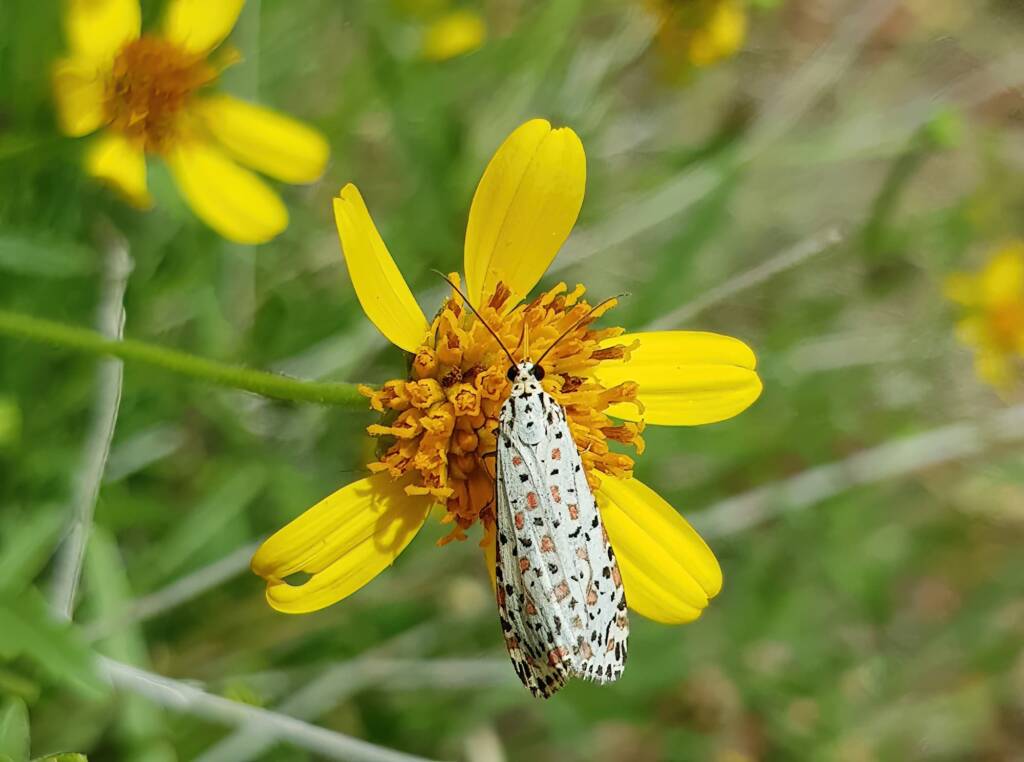The genus Utetheisa was first described by Jacob Hübner in 1819, who are generally known by a number of names including Rattlepod Moths and Tiger Moths.
The caterpillars of many Utetheisa species feed on Crotalaria (rattlebox), hence the genus is often referred to as the Rattlebox Moths.


Individual species have other common names such as Salt and Pepper Moth and Heliotrope Moth (Utetheisa pulchelloides).

They have four wing parts and in flight appear to be white. When they settle on a plant (often seen flying around during the day feeding on flowers), you can see their distinctive pattern.

It is found across the Indo-Australian region including Borneo, Hong Kong, China, New Zealand, Papua, Seychelles, most of Australia and Tenerife. The adult moth has an extensive migratory flight ranges, reaching some of the most remote oceanic islands, such as Henderson Island and Ducie Island. With its vast range, it is not surprising that there are a number of sub-species.2
Identification of Utetheisa
Identification of species often rely on the number of spots along the inner side of the forewings and/or different arrangement of black and red spots. In other species the depth of colour on the hindwings also help define a species such as U. pectinata which has a lot less black on the hind wings and a different arrangement of black and red spots to that of U. pulchelloides and U. lotrix.
The following from Bjørn M Fjellstad provides a way see the differences between the three species of Utetheisa.
As there is often great confusion when it comes to these moths, I took the liberty to make a group photo of them, showing the differences. I know that this is not a photo of live moths, but to be able to clearly show the differences of the 3 Utetheisa species in Australia, it is necessary to show set specimens. Photos are from BOLD and of moths confirmed by CSIRO
Source: © Bjørn M Fjellstad

Exception to the rule
As with some descriptions of moths, identification are not necessarily so definitive, there being exceptions to the rule. The following from Steve Williams…
While the males of U. pulchelloides can be differentiated with confidence based on the presence of the “pouch of hairs” on the hind wing it may be practically impossible to differentiate females. The characteristics you mention above may be true for some but are not universally definitive. These species can be quite variable as the pics below of what will be U. pulchelloides indicate. One is showing only 4 red spots (although the outer one is rather large being the probable combination of two) and the other shows no red pigmentation.
Source: © Steve Williams

- Scientific classification
- Kingdom: Animalia
- Phylum: Arthropoda
- Subphylum: Hexapoda
- Class: Insecta
- Informal: Pterygotes
- Order: Lepidoptera
- Unranked: Ditrysia
- Superfamily: Noctuoidea
- Family: Erebidae
- Subfamily: Arctiinae
- Tribe: Arctiini
- Genus: Utetheisa
- Species:
- Utetheisa aegrotum (Swinhoe, 1892)
- Utetheisa lotrix (Cramer, 1777)
- Utetheisa pectinata Hampson, 1907
- Utetheisa pellex (Linnaeus, 1758)
- Utetheisa pulchelloides Hampson, 1907
Footnote & References
- Many thanks to for ID to Tony Eales and Iskander Kaliananda, member of Entomology Australia “Invertebratology”, https://www.facebook.com/groups/507004496955277/
- Many thanks to Bjørn M Fjellstad his image showing the differences between the species.
- Many thanks to Steve Williams for his image showing variation on U. pulchelloides.
- Utetheisa Hübner, 1819, Atlas of Living Australia, https://bie.ala.org.au/species/https://biodiversity.org.au/afd/taxa/2f4a824a-9660-4b51-b4f4-70d9f042977a
- Rattlepod Moths (Genus Utetheisa), iNaturalistAU, https://inaturalist.ala.org.au/taxa/67441-Utetheisa
- Utetheisa, Wikipedia, https://en.wikipedia.org/wiki/Utetheisa
MothsMoths Index Aedia arctipennis Anthela guenei (Four-Spot Anthelid Moth) Australian Striped Hawk Moth Bag-shelter Moth (Ochrogaster lunifer) Case Moths (Variety of Cocoons) Coenotes eremophilae Convolvulus Hawk Moth Day Flying Moth Emperor Gum Moth (Opodiphthera eucalypti) Four-spotted Cup Moth Green-blotched Moth (Cosmodes elegans) Leaf Case Moth Mistletoe Emperor Moth Plume Moth Rattlepod Moth (Utetheisa) Ribbed Case Moth Sameodes cancellalis Saunders’ Case Moth (Metura elongatus) White-spotted Owl-Moth
